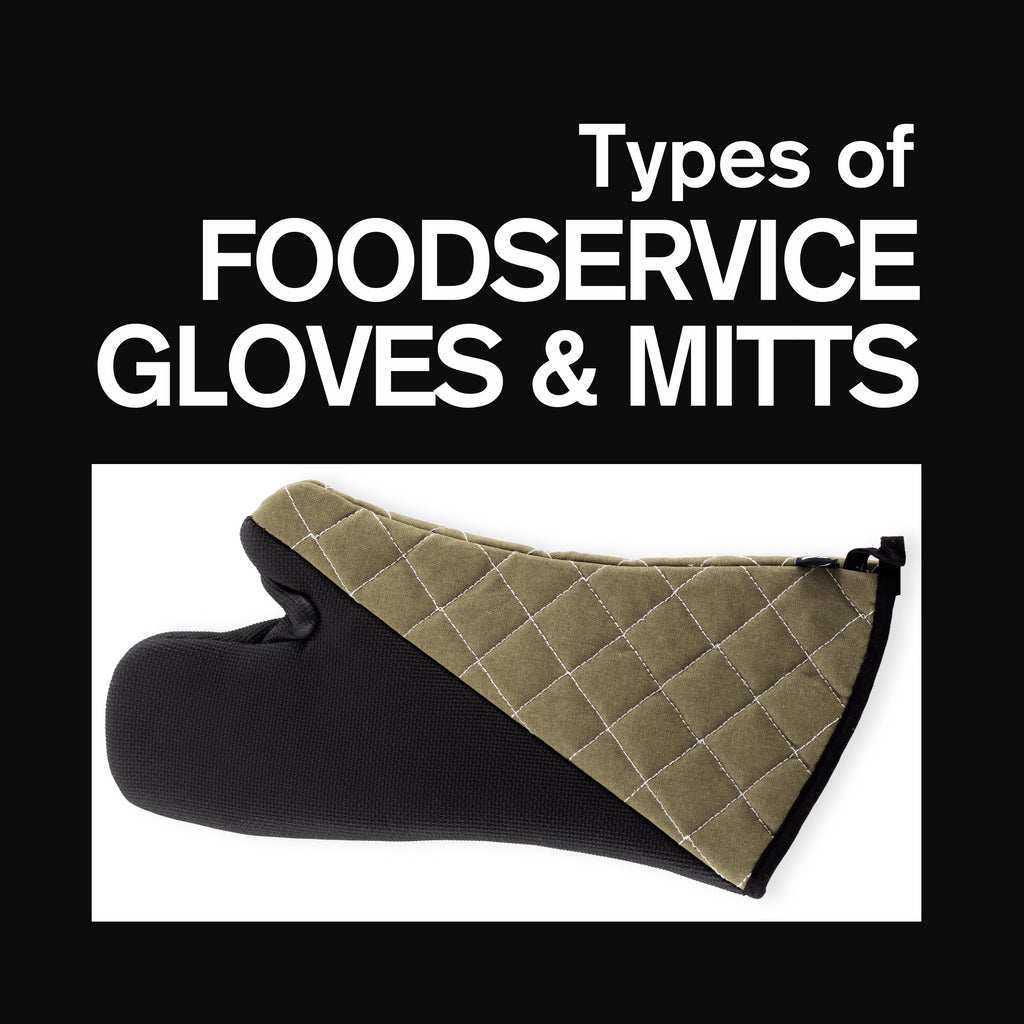Types of Foodservice Gloves & Mitts
Posted by JENNIFER TUMILTY

Types of Foodservice Gloves for Hand Protection
Between COVID-19 and ever-tightening food safety regulations, the use of gloves is increasing dramatically in the foodservice industry.
Cut-Resistant Gloves
Today’s commercial kitchens are full of young, often inexperienced staff who need to be kept safe around sharp knives and slicers. The last thing you need is to be driving an employee to hospital with an injured hand.
While proper training is essential, you can help protect staff further by investing in cut-resistant gloves for tasks such as de-boning and slicing meat, prepping vegetables, even washing knives.
• Most cut-resistant gloves are made of a woven synthetic material of varying thickness. Some, like Kevlar, are lightweight and flame-retardant yet stronger than steel.
• Pay special attention to the thickness of fabric between thumb and forefinger where many injuries occur.
• For maximum protection, choose heavy-duty gloves made of stainless steel mesh. Used in many industries with sharp tools, metal mesh gloves are ideal for butcher shops and kitchens where chefs break down meat and poultry.
• Some cut-resistant gloves are also resistant to heat or moisture.
• Once you’ve chosen a glove, have staff test-drive it. If it’s not comfortable and doesn’t allow enough mobility, employees won’t wear it.

Heat Resistant Gloves - Oven Mitts and Gloves
You’ve probably known at least one chef who’s boasted that they never use oven mitts since there’s always a kitchen towel handy. However, not all staff are comfortable pulling hot items with a towel, nor should be.
• Oven mitts and gloves offer excellent protection when reaching into a hot oven or removing hot pans. They also prevent burns when dropping fries into hot oil. Other types protect from dangerous steam and let you comfortably transfer pans from freezer to oven.
• If you deal with an open flame, choose a flame-retardant material.
• The traditional oven mitt is shaped like a mitten. They usually come in one size, but try on a few styles to find one that’s comfortable yet flexible enough to handle pans and tools. For extra protection, try a longer glove.
• A second style is shaped like a puppet, with the thumb located under the fingers. This style gives you a firm grip on heavier items. While you’re at it, try on a few oven-proof gloves, which provide even better dexterity.
• Cloth mitts with silicone or neoprene inserts can withstand temperatures from 93 to 250°C and provide an excellent grip.
• A loop or magnet makes hanging easy.
• Ask if gloves are machine or dishwasher safe. Also check if they’re sold individually or in pairs.

Dishwashing and Cleaning Gloves
Using gloves for dishwashing and cleaning is about keeping staff clean but also safe.
• Foodservice cleaning staff and dishwashers need heavy-duty gloves that protect their hands from moisture, heat and harsh chemicals.
• Latex, neoprene and vinyl gloves are all recommended, with neoprene considered the winner.
• Neoprene gloves are flexible, heat-resistant, protect against chemicals and can be worn for long periods of time. Most are reusable.
Disposable Gloves for Food Handling
All disposable, single-use gloves offer some protection against germs, stains and harsh chemicals. Here are the most popular materials.
• Strong, flexible latex gloves fit like a second skin. Made of natural rubber, they’re biodegradable and won’t clog landfills. Latex does, however, contain a protein that causes an allergic reaction in some people.
• The best latex alternative, nitrile gloves are durable and hypoallergenic. They fit well and aren’t easily punctured or ripped. Great for chopping.
• Vinyl gloves aren’t as comfortable as latex or nitrile but they’re durable and fine for short-term use. Use for cooking, serving and preparing food. Ideal for tasks that require fingertip sensitivity and durability.
• Light and thin polyethylene gloves are great for serving and handling food. They fit loosely and often come in a mitten shape so they’re easy to slip on and off. Use to serve and plate food or any light task such as stacking sandwiches and tossing salads. Note that poly tears easily and can’t handle heat.

Experts agree that handling food with bare hands contributes to the transmission of foodborne illnesses. Single-use gloves interrupt this transmission and help control cross-contamination. But buying a few boxes of disposable gloves won’t magically keep your kitchen safe.
If staff aren’t trained in how to use gloves properly and when to change them, preparing food with gloved hands can spread germs and contaminate food just as easily as unwashed bare hands.
Gloves do not kill bacteria or viruses, they simply help reduce their spread. Proper handwashing, however, actually does reduce infection.
Tips for effectively using disposable gloves:
Experts agree that handling food with bare hands contributes to the transmission of foodborne illnesses. Single-use gloves interrupt this transmission and help control cross-contamination. But buying a few boxes of disposable gloves won’t magically keep your kitchen safe.
If staff aren’t trained in how to use gloves properly and when to change them, preparing food with gloved hands can spread germs and contaminate food just as easily as unwashed bare hands.
Gloves do not kill bacteria or viruses, they simply help reduce their spread. Proper handwashing, however, actually does reduce infection.
• Wash your hands before donning disposable gloves and whenever you change gloves.
• Replace gloves at least every four hours.
• Replace when changing to a different food station.
• Replace if gloves become ripped, torn or soiled.
• Replace after handling raw meat, seafood or poultry.
• Replace if food is sticking or accumulating on the glove.
• Never touch ready-to-eat food with bare hands. Use gloves and utensils or deli paper.
• Once you remove a disposable glove, do not reuse.
Hand protection in foodservice is about keeping your staff safe and clean, but also about keeping your customers safe.
Written by Cynthia David

